Properties of synaptically evoked astrocyte calcium signal reveal synaptic information processing by astrocytes
- PMID: 15745945
- PMCID: PMC6726085
- DOI: 10.1523/JNEUROSCI.3965-04.2005
Properties of synaptically evoked astrocyte calcium signal reveal synaptic information processing by astrocytes
Erratum in
- J Neurosci. 2005 Mar 16;25(11):3022
Abstract
The synaptic control of the astrocytic intracellular Ca2+ is crucial in the reciprocal astrocyte-neuron communication. Using electrophysiological and Ca2+ imaging techniques in rat hippocampal slices, we investigated the astrocytic Ca2+ signal modulation induced by synaptic terminals that use glutamate and acetylcholine. Ca2+ elevations were evoked by glutamate released from Schaffer collaterals and by acetylcholine, but not glutamate, released by alveus stimulation, indicating that astrocytes discriminate the activity of different synapses belonging to different axon pathways. The Ca2+ signal was modulated bidirectionally by simultaneous activation of both pathways, being depressed at high stimulation frequencies and enhanced at low frequencies. The Ca2+ modulation was attributable to astrocytic intrinsic properties, occurred at discrete regions of the processes, and controlled the intracellular expansion of the Ca2+ signal. In turn, astrocyte Ca2+ signal elicited NMDA receptor-mediated currents in pyramidal neurons. Therefore, because astrocytes discriminate and integrate synaptic information, we propose that they can be considered as cellular elements involved in the information processing by the nervous system.
Figures

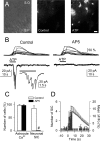
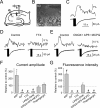
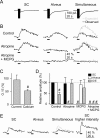
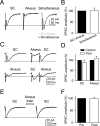
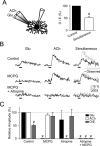

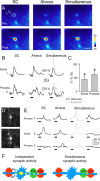
Similar articles
-
Synaptically released acetylcholine evokes Ca2+ elevations in astrocytes in hippocampal slices.J Neurosci. 2002 Apr 1;22(7):2443-50. doi: 10.1523/JNEUROSCI.22-07-02443.2002. J Neurosci. 2002. PMID: 11923408 Free PMC article.
-
Astrocytic glutamate release-induced transient depolarization and epileptiform discharges in hippocampal CA1 pyramidal neurons.J Neurophysiol. 2005 Dec;94(6):4121-30. doi: 10.1152/jn.00448.2005. Epub 2005 Sep 14. J Neurophysiol. 2005. PMID: 16162834
-
Mature hippocampal astrocytes exhibit functional metabotropic and ionotropic glutamate receptors in situ.Glia. 1999 Mar;26(1):1-11. doi: 10.1002/(sici)1098-1136(199903)26:1<1::aid-glia1>3.0.co;2-z. Glia. 1999. PMID: 10088667
-
Synaptic information processing by astrocytes.J Physiol Paris. 2006 Mar-May;99(2-3):92-7. doi: 10.1016/j.jphysparis.2005.12.003. Epub 2006 Jan 25. J Physiol Paris. 2006. PMID: 16442272 Review.
-
Astrocytes process synaptic information.Neuron Glia Biol. 2008 Feb;4(1):3-10. doi: 10.1017/S1740925X09000064. Epub 2009 Feb 27. Neuron Glia Biol. 2008. PMID: 19250562 Review.
Cited by
-
Astrocytes in cocaine addiction and beyond.Mol Psychiatry. 2022 Jan;27(1):652-668. doi: 10.1038/s41380-021-01080-7. Epub 2021 Apr 9. Mol Psychiatry. 2022. PMID: 33837268 Free PMC article. Review.
-
In vivo knockdown of astroglial glutamate transporters GLT-1 and GLAST increases excitatory neurotransmission in mouse infralimbic cortex: Relevance for depressive-like phenotypes.Eur Neuropsychopharmacol. 2019 Nov;29(11):1288-1294. doi: 10.1016/j.euroneuro.2019.09.004. Epub 2019 Oct 1. Eur Neuropsychopharmacol. 2019. PMID: 31582286 Free PMC article.
-
Glia mechanisms in mood regulation: a novel model of mood disorders.Psychopharmacology (Berl). 2007 Mar;191(1):55-65. doi: 10.1007/s00213-006-0652-4. Epub 2007 Jan 16. Psychopharmacology (Berl). 2007. PMID: 17225169
-
Astrocytic modulation of excitatory synaptic signaling in a mouse model of Rett syndrome.Elife. 2018 Jan 9;7:e31629. doi: 10.7554/eLife.31629. Elife. 2018. PMID: 29313799 Free PMC article.
-
Astrocyte IP3R2-dependent Ca(2+) signaling is not a major modulator of neuronal pathways governing behavior.Front Behav Neurosci. 2014 Nov 12;8:384. doi: 10.3389/fnbeh.2014.00384. eCollection 2014. Front Behav Neurosci. 2014. PMID: 25429263 Free PMC article.
References
-
- Araque A, Parpura V, Sanzgiri RP, Haydon PG (1998a) Glutamate-dependent astrocyte modulation of synaptic transmission between cultured hippocampal neurons. Eur J Neurosci 10: 2129-2142. - PubMed
-
- Araque A, Parpura V, Sanzgiri RP, Haydon PG (1999) Tripartite synapses: glia, the unacknowledged partner. Trends Neurosci 22: 208-215. - PubMed
Publication types
MeSH terms
Substances
LinkOut - more resources
Full Text Sources
Miscellaneous
